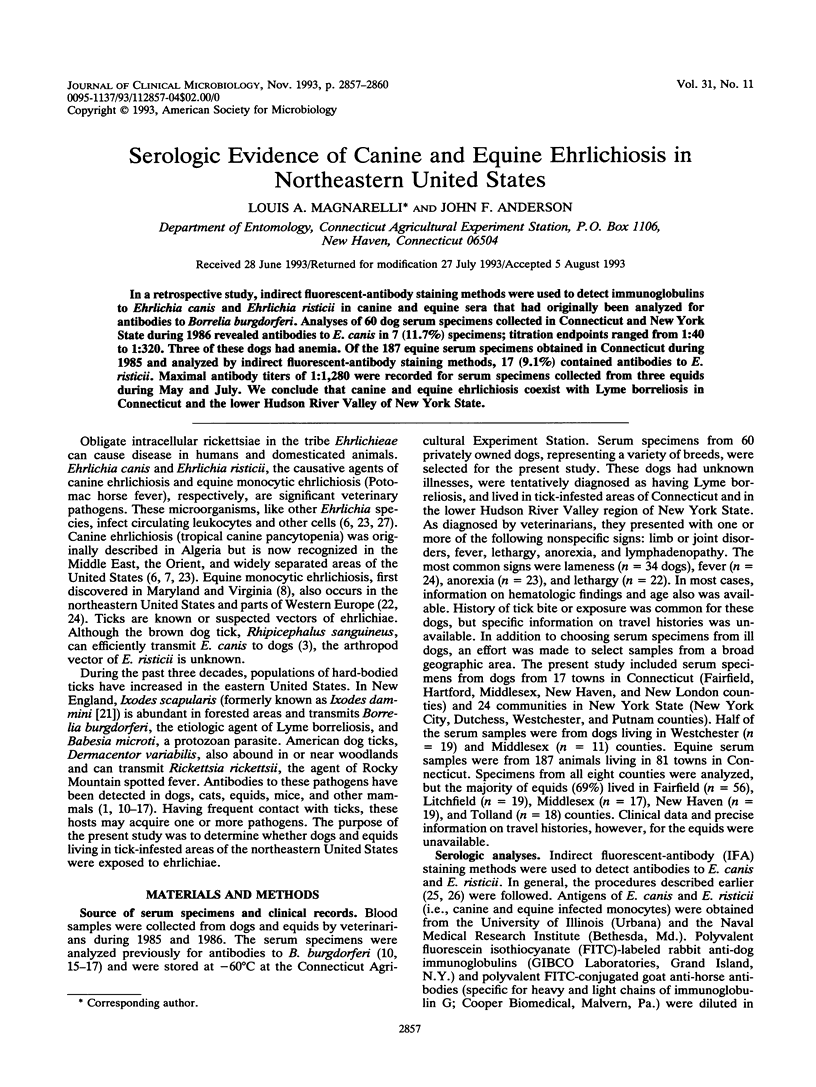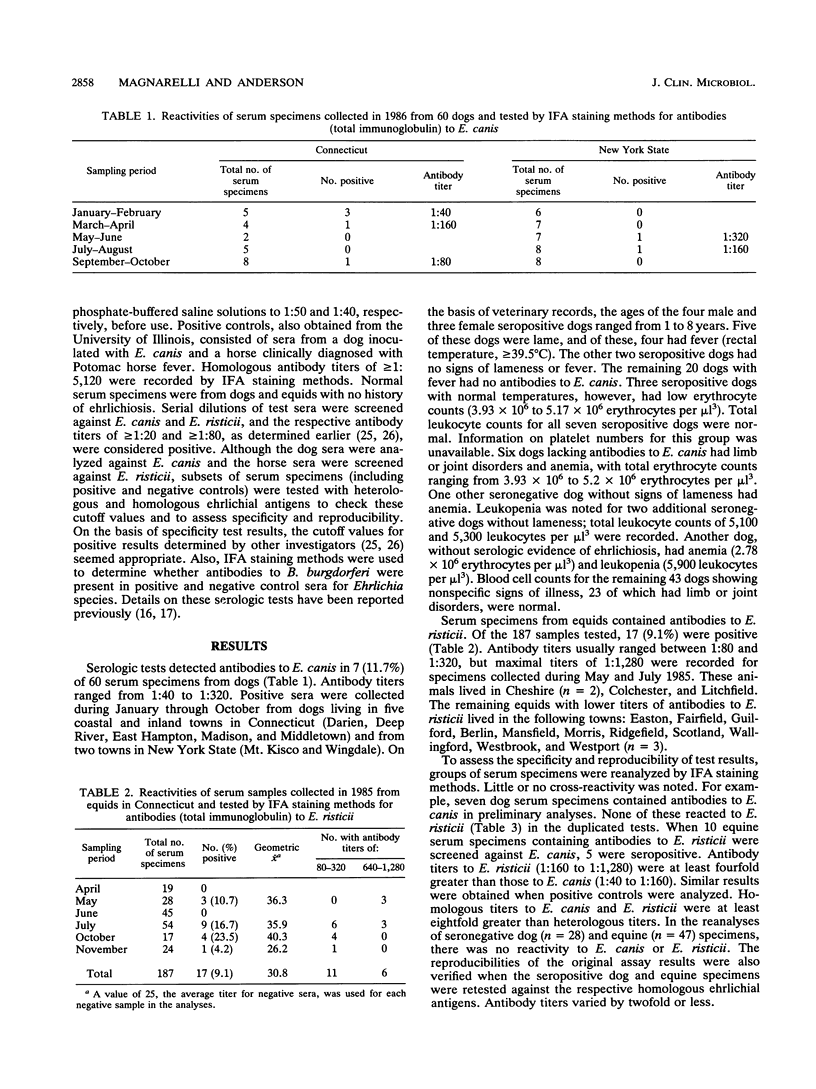Abstract
In a retrospective study, indirect fluorescent-antibody staining methods were used to detect immunoglobulins to Ehrlichia canis and Ehrlichia risticii in canine and equine sera that had originally been analyzed for antibodies to Borrelia burgdorferi. Analyses of 60 dog serum specimens collected in Connecticut and New York State during 1986 revealed antibodies to E. canis in 7 (11.7%) specimens; titration endpoints ranged from 1:40 to 1:320. Three of these dogs had anemia. Of the 187 equine serum specimens obtained in Connecticut during 1985 and analyzed by indirect fluorescent-antibody staining methods, 17 (9.1%) contained antibodies to E. risticii. Maximal antibody titers of 1:1,280 were recorded for serum specimens collected from three equids during May and July. We conclude that canine and equine ehrlichiosis coexist with Lyme borreliosis in Connecticut and the lower Hudson River Valley of New York State.
Full text
PDF



Selected References
These references are in PubMed. This may not be the complete list of references from this article.
- Anderson J. F., Magnarelli L. A., Kurz J. Intraerythrocytic parasites in rodent populations of Connecticut: Babesia and Grahamella species. J Parasitol. 1979 Aug;65(4):599–604. [PubMed] [Google Scholar]
- Anziani O. S., Ewing S. A., Barker R. W. Experimental transmission of a granulocytic form of the tribe Ehrlichieae by Dermacentor variabilis and Amblyomma americanum to dogs. Am J Vet Res. 1990 Jun;51(6):929–931. [PubMed] [Google Scholar]
- Groves M. G., Dennis G. L., Amyx H. L., Huxsoll D. L. Transmission of Ehrlichia canis to dogs by ticks (Rhipicephalus sanguineus). Am J Vet Res. 1975 Jul;36(7):937–940. [PubMed] [Google Scholar]
- Holland C. J., Ristic M., Cole A. I., Johnson P., Baker G., Goetz T. Isolation, experimental transmission, and characterization of causative agent of Potomac horse fever. Science. 1985 Feb 1;227(4686):522–524. doi: 10.1126/science.3880925. [DOI] [PubMed] [Google Scholar]
- Hoskins J. D., Breitschwerdt E. B., Gaunt S. D., French T. W., Burgdorfer W. Antibodies to Ehrlichia canis, Ehrlichia platys, and spotted fever group rickettsiae in Louisiana dogs. J Vet Intern Med. 1988 Apr-Jun;2(2):55–59. doi: 10.1111/j.1939-1676.1988.tb02793.x. [DOI] [PubMed] [Google Scholar]
- Keefe T. J., Holland C. J., Salyer P. E., Ristic M. Distribution of Ehrlichia canis among military working dogs in the world and selected civilian dogs in the United States. J Am Vet Med Assoc. 1982 Aug 1;181(3):236–238. [PubMed] [Google Scholar]
- Magnarelli L. A., Anderson J. F., Burgdorfer W., Chappell W. A. Parasitism by Ixodes dammini (Acari: Ixodidae) and antibodies to spirochetes in mammals at Lyme disease foci in Connecticut, USA. J Med Entomol. 1984 Jan 26;21(1):52–57. doi: 10.1093/jmedent/21.1.52. [DOI] [PubMed] [Google Scholar]
- Magnarelli L. A., Anderson J. F., Burgdorfer W., Philip R. N., Chappell W. A. Antibodies to Rickettsia rickettsii in Peromyscus leucopus from a focus of Rocky Mountain spotted fever in Connecticut. Can J Microbiol. 1984 Apr;30(4):491–494. doi: 10.1139/m84-072. [DOI] [PubMed] [Google Scholar]
- Magnarelli L. A., Anderson J. F. Class-specific and polyvalent enzyme-linked immunosorbent assays for detection of antibodies to Borrelia burgdorferi in equids. J Am Vet Med Assoc. 1989 Nov 15;195(10):1365–1368. [PubMed] [Google Scholar]
- Magnarelli L. A., Anderson J. F., Levine H. R., Levy S. A. Tick parasitism and antibodies to Borrelia burgdorferi in cats. J Am Vet Med Assoc. 1990 Jul 1;197(1):63–66. [PubMed] [Google Scholar]
- Magnarelli L. A., Anderson J. F., Philip R. N., Burgdorfer W. Antibodies to spotted fever-group rickettsiae in dogs and prevalence of infected ticks in southern Connecticut. Am J Vet Res. 1982 Apr;43(4):656–659. [PubMed] [Google Scholar]
- Magnarelli L. A., Anderson J. F., Schreier A. B., Ficke C. M. Clinical and serologic studies of canine borreliosis. J Am Vet Med Assoc. 1987 Nov 1;191(9):1089–1094. [PubMed] [Google Scholar]
- Magnarelli L. A., Anderson J. F., Schreier A. B. Persistence of antibodies to Borrelia burgdorferi in dogs of New York and Connecticut. J Am Vet Med Assoc. 1990 Apr 1;196(7):1064–1068. [PubMed] [Google Scholar]
- Magnarelli L. A., Anderson J. F., Shaw E., Post J. E., Palka F. C. Borreliosis in equids in northeastern United States. Am J Vet Res. 1988 Mar;49(3):359–362. [PubMed] [Google Scholar]
- Magnarelli L. A., Andreadis T. G., Stafford K. C., 3rd, Holland C. J. Rickettsiae and Borrelia burgdorferi in ixodid ticks. J Clin Microbiol. 1991 Dec;29(12):2798–2804. doi: 10.1128/jcm.29.12.2798-2804.1991. [DOI] [PMC free article] [PubMed] [Google Scholar]
- Magnarelli L. A., Litwin H. J., Holland C. J., Anderson J. F., Ristic M. Canine ehrlichiosis in Connecticut. J Clin Microbiol. 1990 Feb;28(2):366–367. doi: 10.1128/jcm.28.2.366-367.1990. [DOI] [PMC free article] [PubMed] [Google Scholar]
- McDade J. E. Ehrlichiosis--a disease of animals and humans. J Infect Dis. 1990 Apr;161(4):609–617. doi: 10.1093/infdis/161.4.609. [DOI] [PubMed] [Google Scholar]
- Oliver J. H., Jr, Owsley M. R., Hutcheson H. J., James A. M., Chen C., Irby W. S., Dotson E. M., McLain D. K. Conspecificity of the ticks Ixodes scapularis and I. dammini (Acari: Ixodidae). J Med Entomol. 1993 Jan;30(1):54–63. doi: 10.1093/jmedent/30.1.54. [DOI] [PubMed] [Google Scholar]
- Palmer J. E., Whitlock R. H., Benson C. E. Equine ehrlichial colitis (Potomac horse fever): recognition of the disease in Pennsylvania, New Jersey, New York, Ohio, Idaho, and Connecticut. J Am Vet Med Assoc. 1986 Jul 15;189(2):197–199. [PubMed] [Google Scholar]
- Rikihisa Y. The tribe Ehrlichieae and ehrlichial diseases. Clin Microbiol Rev. 1991 Jul;4(3):286–308. doi: 10.1128/cmr.4.3.286. [DOI] [PMC free article] [PubMed] [Google Scholar]
- Ristic M., Holland C. J., Dawson J. E., Sessions J., Palmer J. Diagnosis of equine monocytic ehrlichiosis (Potomac horse fever) by indirect immunofluorescence. J Am Vet Med Assoc. 1986 Jul 1;189(1):39–46. [PubMed] [Google Scholar]
- Ristic M., Huxsoll D. L., Weisiger R. M., Hildebrandt P. K., Nyindo M. B. Serological diagnosis of tropical canine pancytopenia by indirect immunofluorescence. Infect Immun. 1972 Sep;6(3):226–231. doi: 10.1128/iai.6.3.226-231.1972. [DOI] [PMC free article] [PubMed] [Google Scholar]
- Woody B. J., Hoskins J. D. Ehrlichial diseases of dogs. Vet Clin North Am Small Anim Pract. 1991 Jan;21(1):75–98. doi: 10.1016/s0195-5616(91)50009-7. [DOI] [PubMed] [Google Scholar]


